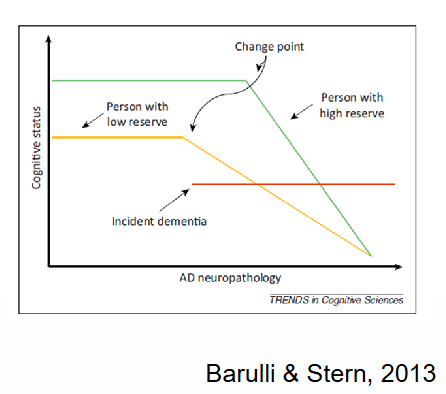Lecture 5 - Cognitive development part 2: Memory and Information processing
1/72
There's no tags or description
Looks like no tags are added yet.
Name | Mastery | Learn | Test | Matching | Spaced |
|---|
No study sessions yet.
73 Terms
What part of the brain has the most prolonged development?
Prefrontal regions of the frontal lobe
• Around 1st year peak in synaptic density
• Around 15th year synaptic density at adult level
• Myelination continues until early adulthood!
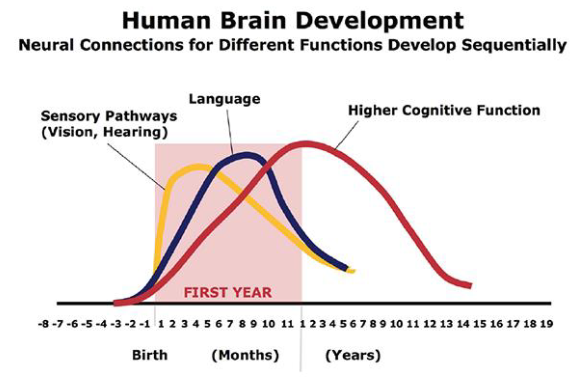
What are the 7 areas of the Frontal lobe and 4 functions?
Abstract thinking
Problem solving
Reasoning
Executive functioning
Organizing
Motor functions
Regulates emotions
Expressive language
4 Functions
Organizes thoughts on paper
Remembers facts
Starts and completes tasks
Tells stories
In what area are Executive functions (EF) regulated?
Prefrontal cortex — higher cognitive functions.
What is EF an umbrella term for? What are the 3 corresponding abilities?
Cognitive skills guiding goal-directed behavior:
Cognitive flexibility / Shifting (ability to shift between tasks)
Inhibition (ability to stop or suppress actions)
Updating (ability to keep information ‘online’)
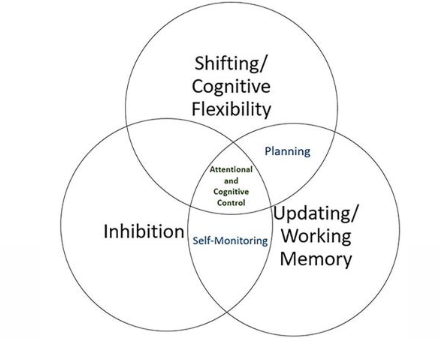
What was the result of the Shifting task of Executive functions?
Participants are less accurate and slower when they need to switch task sets.
3- & 4-year-olds can shift between two simple, contextualized response sets
Between 5 and 6 years further improvement in more complex shifting task
→ generalizing rules to new, unseen objects
With increasing age until early adolescence, steady increase in proportion of children who master complex shifting tasks
Shift cost (= difference between shift and non-shift trials) greater for 7- and 11-year-olds than for 15-year-olds, 15-year-olds comparable to young adults
Speed-accuracy tradeoff: slowing down to enhance accuracy: more noticeable across childhood → emerging presence of metacognition
• In older age, marked age-related decline: higher shift cost
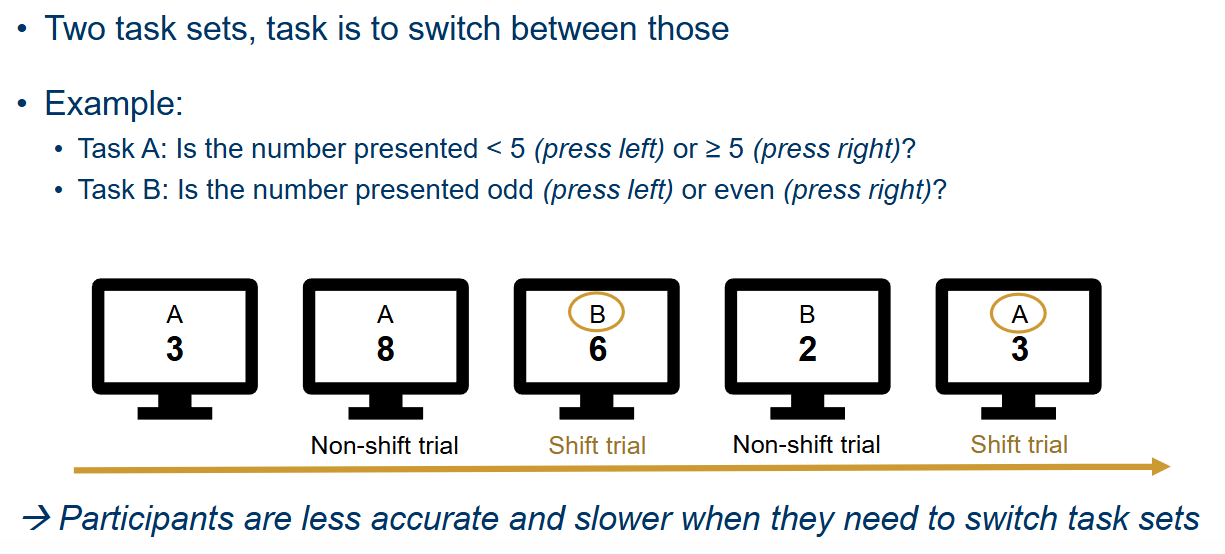
What is shift cost? What age is this the greatest?
Difference between shift and non-shift trials.
Greater for 7- and 11-year-olds than 15-year-olds
15 year-olds comparable to young adults
What is the speed-accuracy tradeoff? When is this most noticable?
Slowing down to enhance accuracy.
More noticeable across childhood → Emerging presence of metacognition.
What are the 4 types of Inhibition in Executive functioning?
Motor inhibition: e.g. dancing, but when the music stops, do not move anymore.
Oculomotor inhibition: Flanker tasks: “respond to direction of arrow in center”
Simple response inhibition tasks: “press key if background is green, but do not press it if background is red.
Cognitive inhibition: Stroop task “name the color of the word”
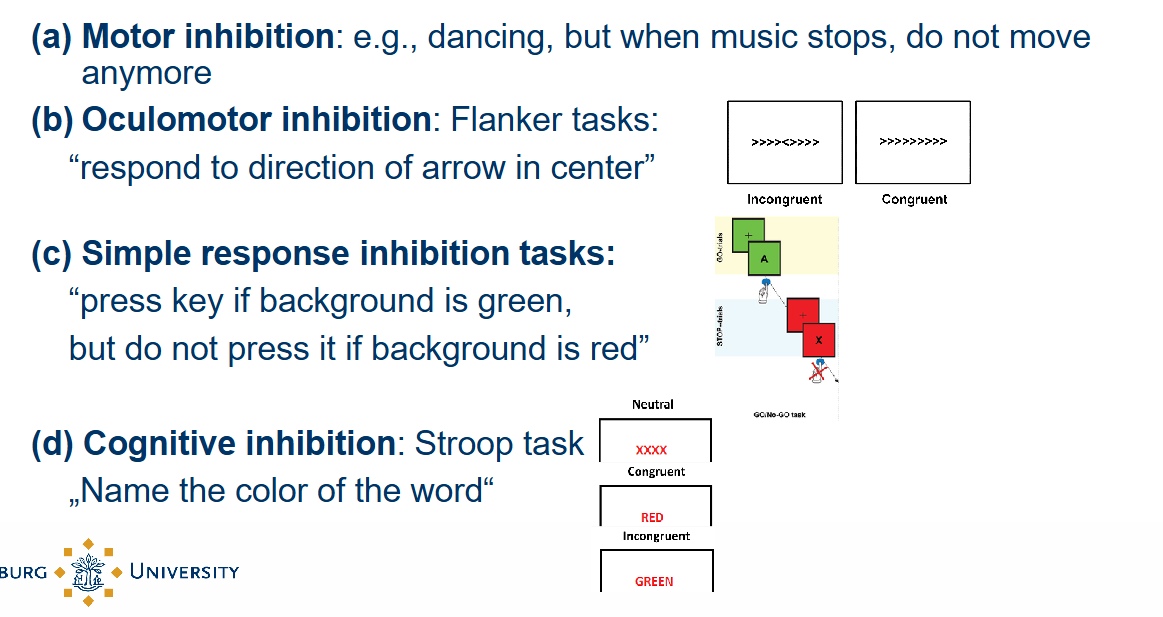
What is seen in early childhood with regards to Inhibition?
Rapid improvements → first signs.
What is seen in preschool years with regards to Inhibition?
Significant reduction of inhibition errors.
When do significant improvements regarding Inhibition occur?
Particularly between ages 5-8 year.
What is seen in middle childhood with regards to Inhibition?
Continued improvements on
a) motor inhibition
b) oculomotor inhibition
c) simple response inhibition tasks
What is seen in adolescence and adulthood with regards to Inhibition?
Little further improvement, continued improvement on oculomotor and response inhibition tasks until age 15, and until age 21 on a (d) cognitive inhibition task.
What is seen in Aging with regards to Inhibition?
Decline in response inhibition
no age-related decline in oculomotor inhibition and cognitive inhibition.
During what ages do these changes occur?
Fundamental changes in inhibition
Refinements in speed and accuracy of inhibition
Differential effects
During preschool
In school age and adolescence
Aging
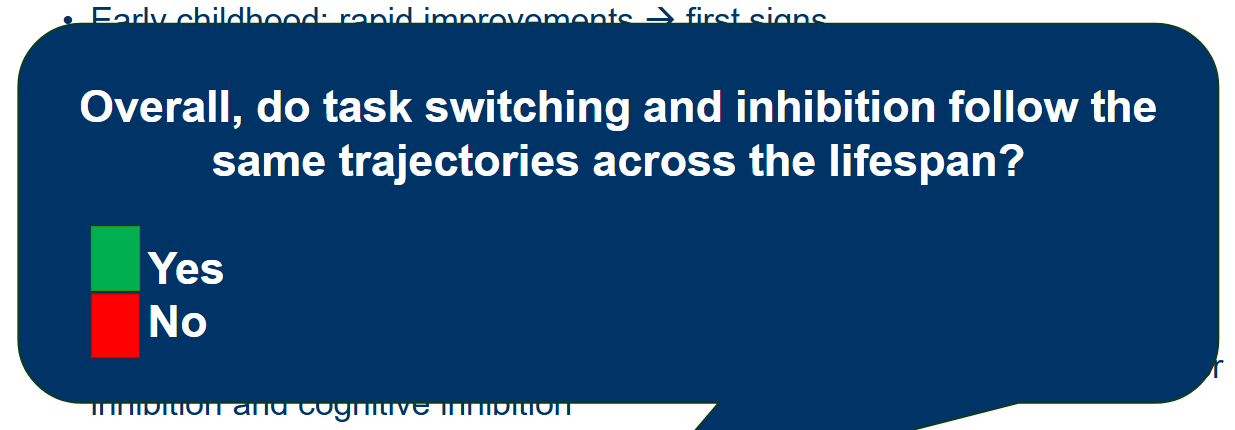
depends on kind of inhibition
Response inhibition = trajectory same
Oculomotor and cognitive = different trajectory due to aging.
What is Short-term memory?
Passive short-term storage: Retaining information for up to 20 seconds without rehearsal of information → Longer retention with rehearsal.
In early childhood there is a very limited capacity of memory (short-term memory span) → this increases during childhood; how?
• From about two digits in 2- to 3-year-old children to five digits in 7-year-olds
• Between 7 and 12 years of age, memory span increased only by 1.5 digits
How does short-term memory span show in aging?
Older adults retain about 90% of the elements that younger adults can retain — only small age-related decline.
Much smaller age effects than for working memory.
What is Working memory?
Active short-term storage: systems that keep things in mind while performing complex tasks like reasoning, comprehension and learning.
How does Complexity of WM task affect trajectories of WM development?
Easier WM tasks are mastered before more complex ones.
Young preschool age children can hold a couple of items in mind simultaneously, developmental differences emerge only by increasing the memory load
Does Working memory have a fast or slow development?
Slow development: by 8 years of age, children can only hold half the items that adults can remember in memory.
Children who have better working memory are more advanced in what 3 skills?
Language comprehension
Math skills
Problem solving
What happens in adolescence with regard to memory (WM)?
Further brain maturation.
Greater functional use of working memory
Information processed more quickly
Simultaneous process of more chunks of information
→ 13-year-olds with greater working memory ability show better performance on a variety of academic subjects
→ Lower working memory associated with impulsivity and adolescent alcohol use
What is the relationship between WM and Age?
WM capacity diminishes with age.
Disagreement on peak: after 20s (see fig.) or around 45 years.

In aging, WM capacity predicts performance on a range of what 3 cognitive tasks?
Long-term memory
Problem-solving
Tests of intelligence
What does the Taxonomy of memory systems look like?
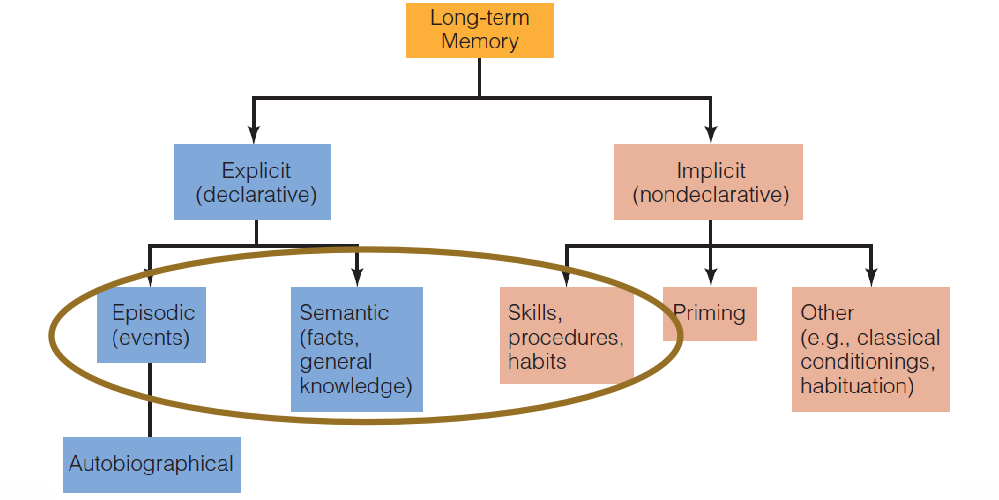
What are the 3 types of Long-term memory?
Procedural memory
Semantic memory
Episodic memory
What does Procedural memory entail?
Automatic, unconscious memory (often motor memory).
ex. Being able to prepare coffee.
What does Semantic memory entail?
Knowledge of facts, concepts, word meanings.
ex. Knowing what coffee is.
What does Episodic memory entail?
Remembering specific episodes that one has experienced.
ex. Remembering having had coffee with a friend last week.
Implicit memory develops [earlier / later] in infancy than explicit memory.
Earlier.
Infants as young as 2½ months of age can retain information from the experience of being conditioned
Implicit memory changes [a lot / little] across the lifespan.
Little.
• Young children often do no worse than older children
• Older adults often do no worse than younger adults
→ Young and old alike learn and retain a tremendous amount of information from their everyday experiences without any effort
• With advancing age, affected by biological decline (decreasing balance, tremor, fatigue,...
What is the relationship between Semantic memory and Age?
• Growth during childhood as a function of a child’s exposure to information
→ environmental context, acculturation, social status, schooling
• Preserved with age – even expansion in some areas (vocabulary, historical facts)
Knowledge and skills learned long ago persist for long periods of time → permastore
BUT older adults have difficulties with tip-of-the-tongue, word finding, retrieval of proper names
→ Older adults show difficulties when semantic information needs to be accessed rapidly + according to arbitrary rules such as word fluency
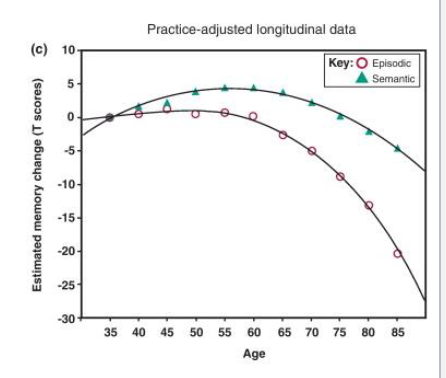
Development (of episodic memory in childhood) starts with what part of the brain?
Hippocampus maturation (second half of 1st year).
Across second year of life: substantial improvements of Episodic memory in childhood → What do we see?
6-month-olds can remember information for 24 hours but by 20 months of age infants can remember information they encountered 12 months earlier.
Still, most conscious memories of young infants are fragile and short-lived.
What is the difference between 6-month-olds and 20-month-olds regarding remembering information?
6-month-olds can remember information for 24 hours but by 20 months of age infants can remember information they encountered 12 months earlier.
What can we seen from 3-5 years of age regarding Episodic memory in childhood?
Children
Increasingly remember events as occurring at a specific time and location
Include more elements that are rich in detail in their narratives
During preschool years, young children increasingly remember more […] characteristics → in some areas reasonably good memories.
Autobiographical.
What are advancements of memory as children move into the middle and late childhood years?
Children’s episodic long-term memory improves even more as they move into the middle and late childhood years: advancements especially in strategies use.
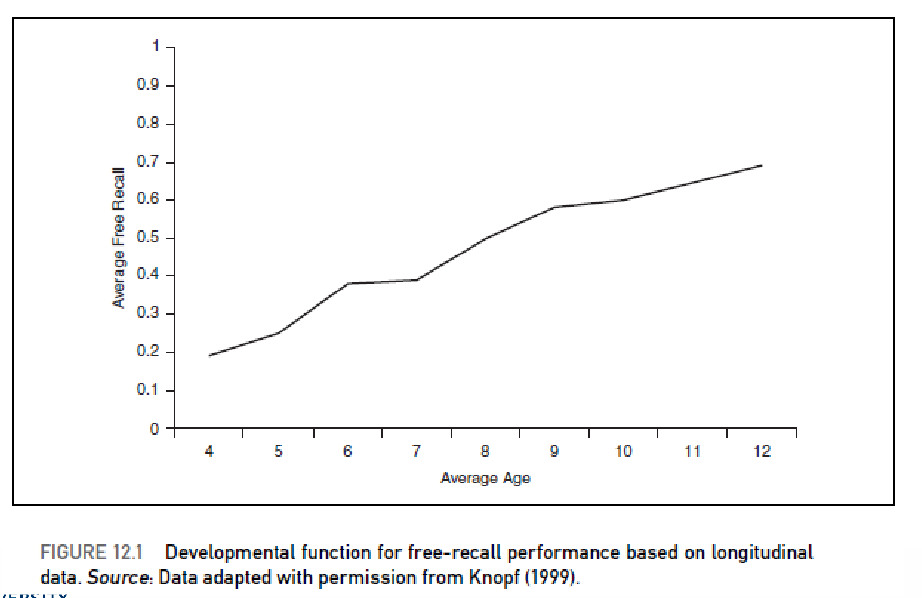
What are the 3 types of Memory strategies?
• Use of mental activities to improve processing of information
• Not much used by preschool children but older children (and adults)
• Encoding strategy usage increases gradually:
Rehearsal (repetition): beneficial for short-term memory
Organization: beneficial for long-term memory, including Imagery for verbal information
Elaboration on the information to be remembered, and making it personally relevant: beneficial for long-term memory
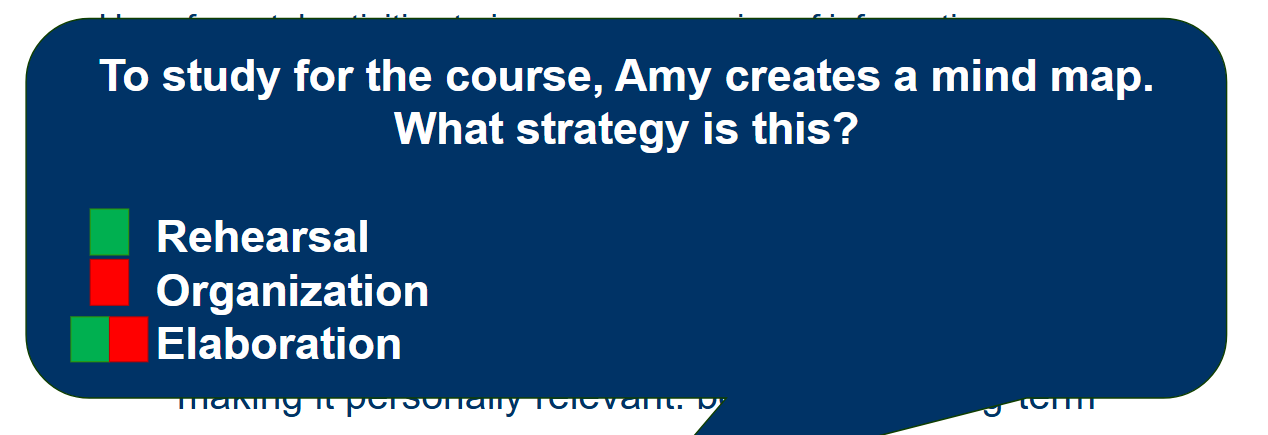
Organization
Episodic memory in adolescence
• Episodic memory performance of young teens (11–12 years) similar to children, both groups markedly worse than young adults
→ New strategies during adolescence:
Memory strategy of elaboration is mastered
• Develop and refine advanced learning and memory strategies highly relevant to school learning
• More deliberate use of strategies than younger children
• More selective use of strategies, only on relevant material
What is a new strategy developed during adolescence?
Memory strategy of elaboration is mastered.
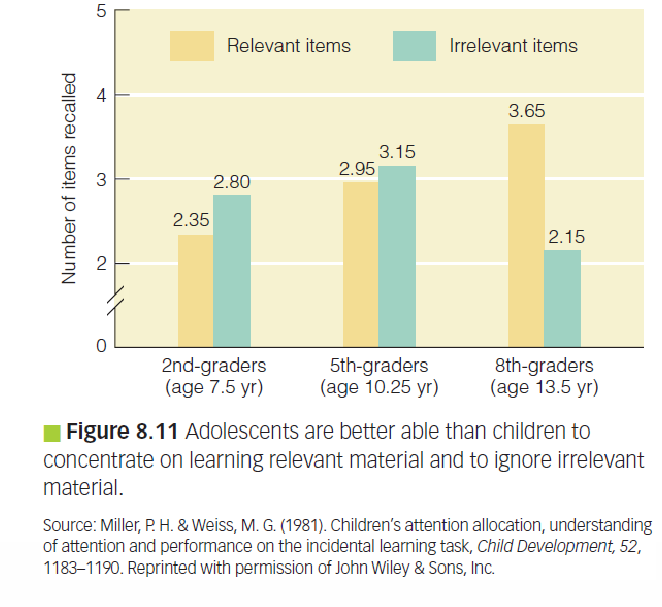
Episodic memory in adulthood
• Relatively stable in middle adulthood
• Declines steadily through the older adult years
• Magnitude of the decline depends on the nature of the task and the method of testing
Retrieval condition
Type of memories (items vs associations)

What does the magnitude of episodic memory decline depend on?
Nature of the task and the method of testing.
Retrieval condition
Type of memories (items vs. associations)
Ages differences in EM: Retrieval condition
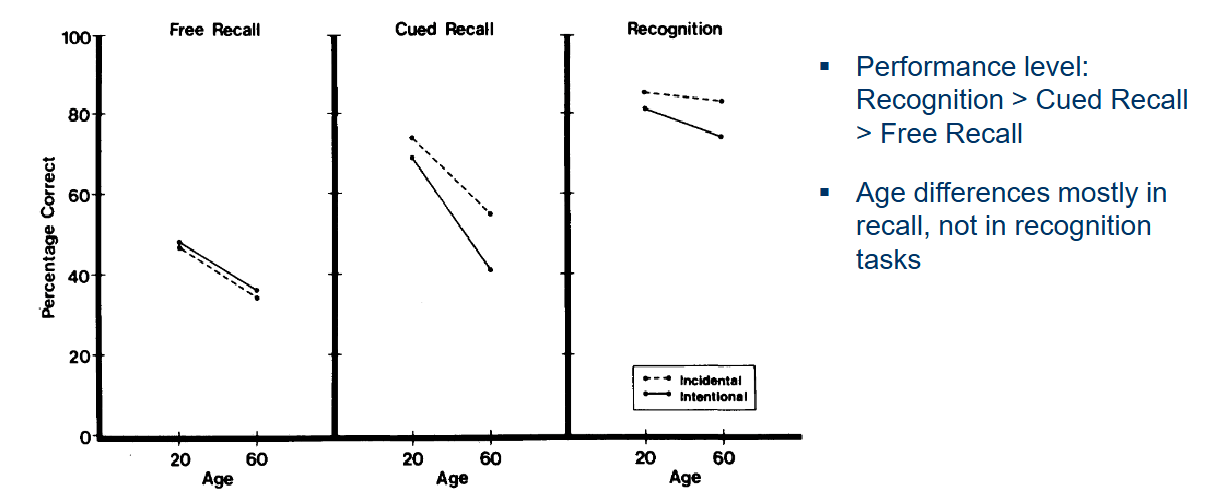
Design to test EM for single information and associations
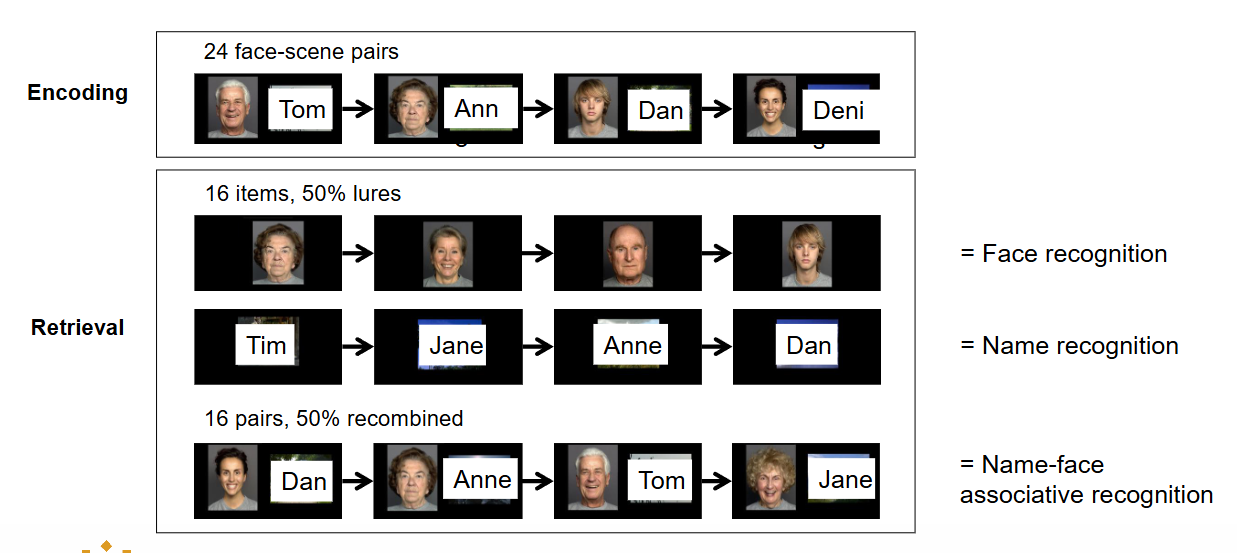
Associative deficit hypothesis
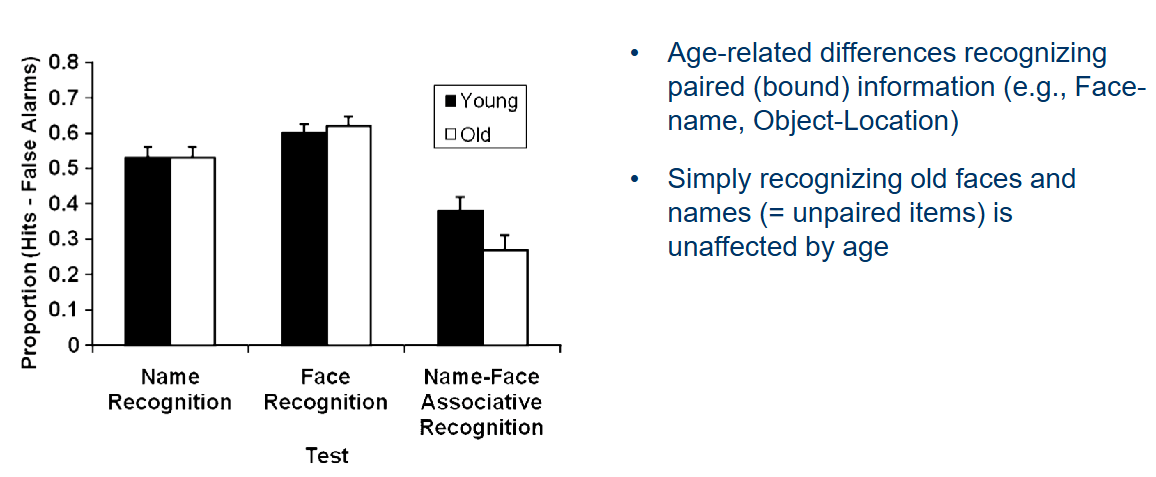
Methodological considerations: Cross-sectional vs. Longitudinal assessment of cognition

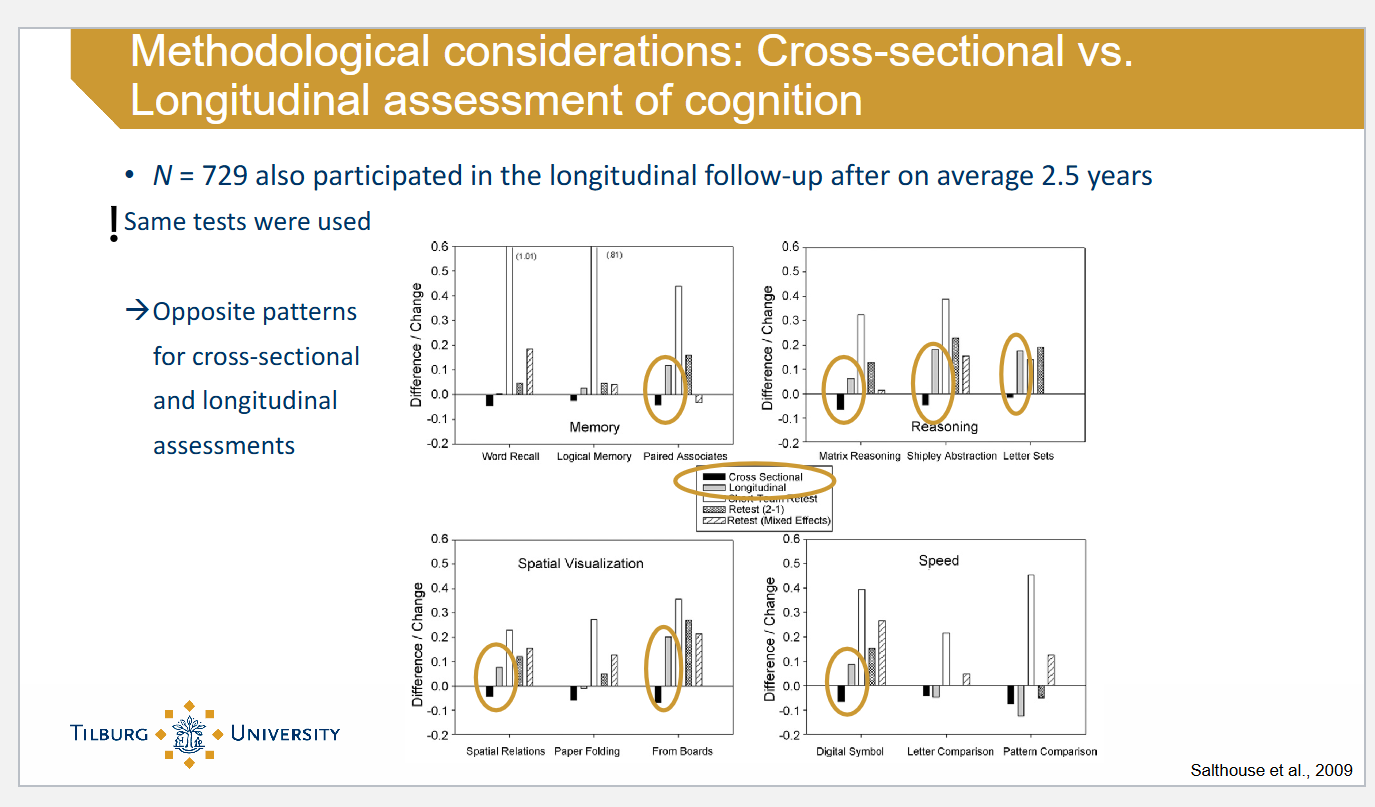
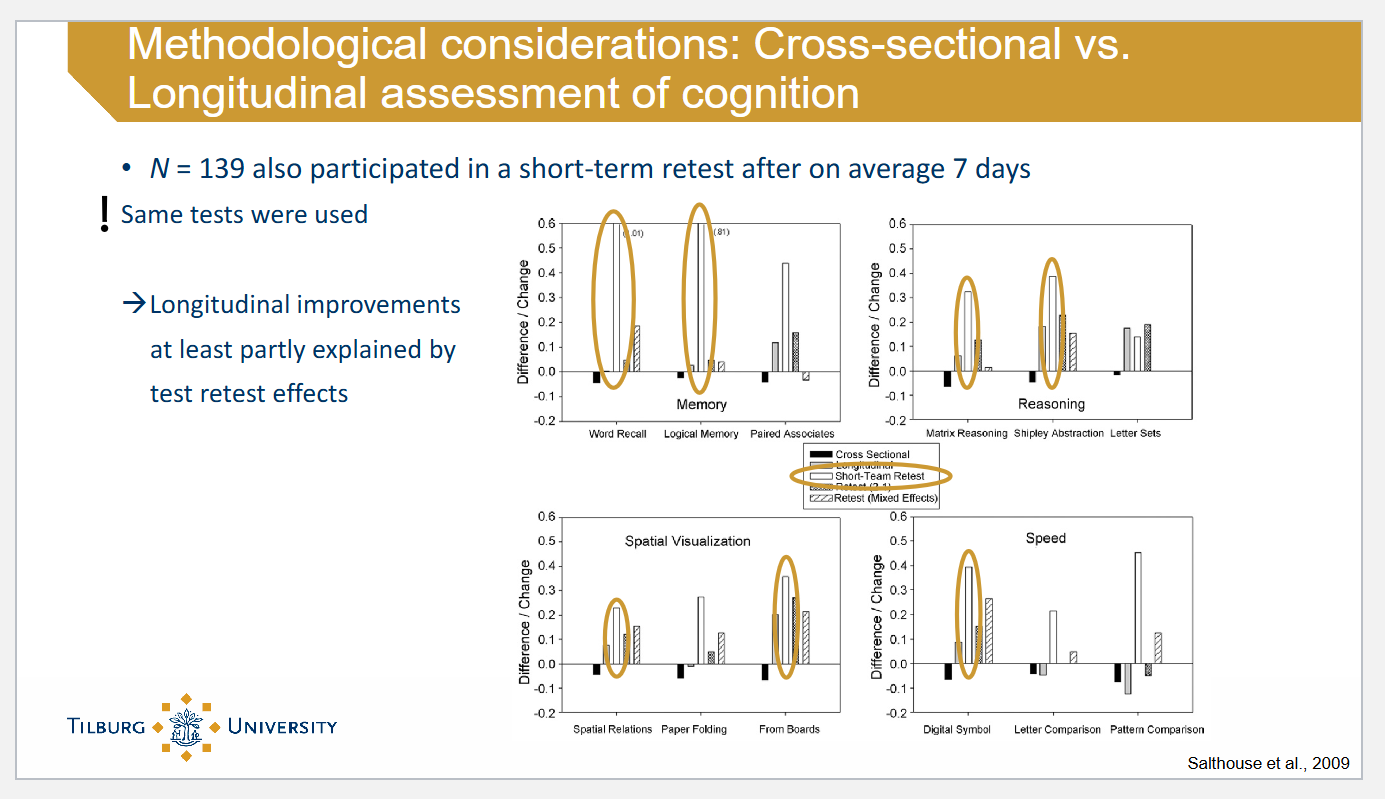
4 hypotheses why learning and memory improve and decline
1. Changes in basic capacities (“hardware”)
Working memory space for manipulating and processing information
2. Changes in memory strategies (“software”)
Effective methods for storing information and retrieving
3. Knowledge of memory
Results in selecting appropriate strategies to learn
4. Knowledge of the world
To-be-learned material more familiar → easier to learn and remember
Mechanisms — Changes in basic capacities between Childhood and Older age
Childhood
Not much change in sensory register and storage capacity of long-term memory
Encoding improves as prefrontal cortex and medial temporal lobes mature
Maturation of hippocampus + other parts of the brain
Speed of mental processes improves → allows to simultaneously perform more mental operations in working memory than young children can
Older age
Declines in sensory abilities strain available processing resources
Not much change in short-term memory, but decline in working-memory (PFC↓)
Inhibition deficit
Slower functioning of the nervous system → reduced speed of processing
Mechanisms — Changes in memory strategies between Childhood and Older age
Childhood
More strategy usage when goal is personally relevant and if instructed to remember
Gradual development: 1. Rehearsal, 2. Organization, 3. Elaboration
Younger children (< 4 years): perseveration errors → stick to old strategy
Despite knowledge on strategies, deficient spontaneous usage
Older age
Many older adults do not spontaneously use strategies
When prompted to use a strategy, older adults show improved memory performance
Bigger effect for individuals with high levels of intelligence → correct strategy implementation
Positive effect of strategy training
What is the gradual development of Memory strategies in Childhood?
Rehearsal
Organization
Elaboration
Mechanisms — Changes in memory knowledge between Childhood and Older age
Childhood
Metacognitive awareness present in a rudimentary form at a young age, significant improvements throughout childhood
Children with greater metamemory awareness often better memory ability
Good metamemory no guarantee of good recall → children must be motivated to use appropriate strategy
Development continues in adolescence: only 50–60% plan for difficult tasks, but 80% monitor performance during task
Older age
Metacognitive knowledge maintained
Are able to monitor their memory, but at times misjudge the accuracy of some aspects of their memory
Negative beliefs about their memory skills → age stereotypes
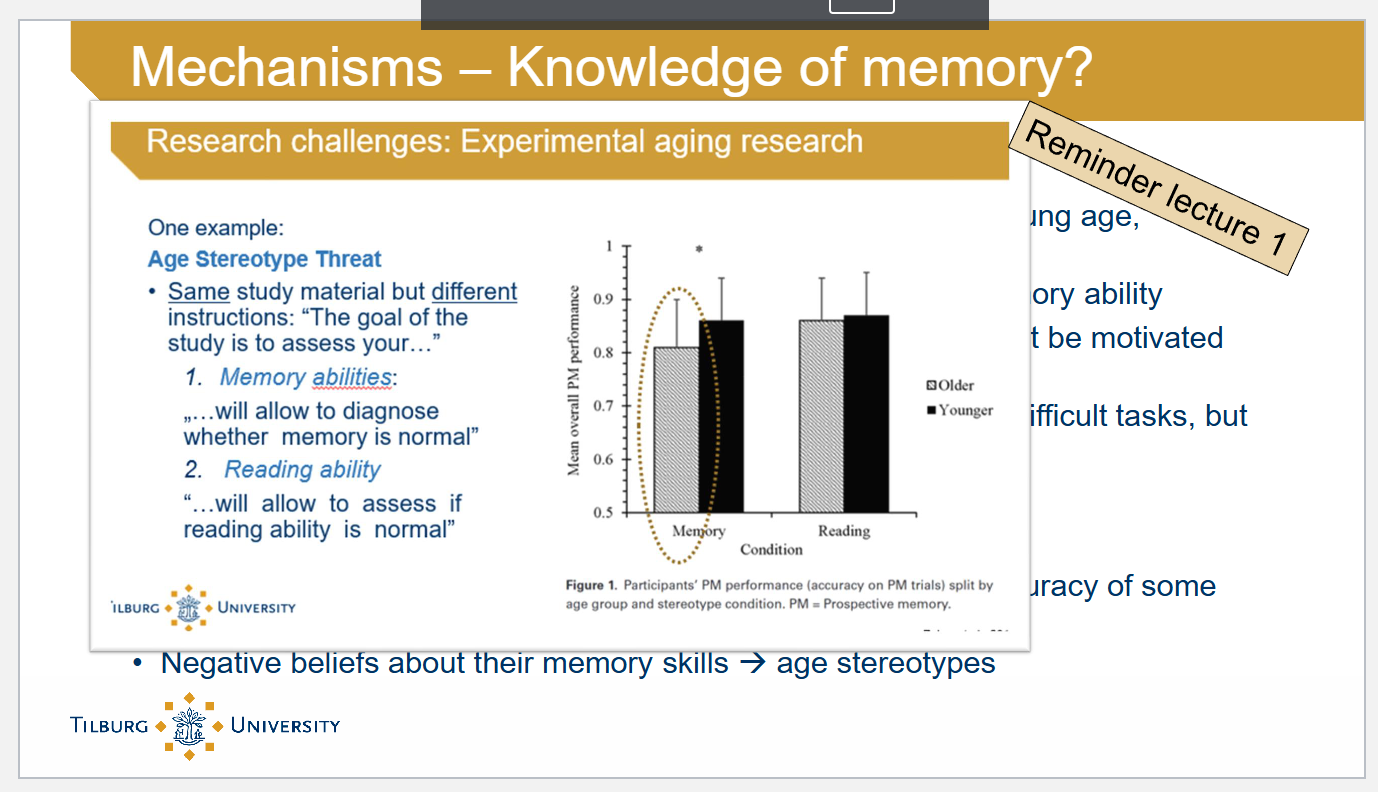
Mechanisms — Changes in knowledge of the world between Childhood and Older age
Childhood
Even though adults typically outperform children on memory tests, this age difference could be reversed if children have more expertise than adults vs.
Controlling of familiarity of material, older children and young adults still perform better than younger children
→ Memory improvements not solely attributable to greater knowledge base
Older age
At least as knowledgeable as young adults (+ further improvements)
→ Knowledge not source of memory problems, rather help to compensate for losses in information-processing efficiency
Mechanisms — Changes in mechanisms underlying change between Childhood and Older age

What are some Contextual factors in aging?
Biological and genetic factors + environmental and situational factors.
Characteristics of the learner
Characteristics of the task or situation
Characteristics of the broader environment, including cultural context
Cohort differences in education and IQ, as well as health and lifestyle.
In familiar contexts often high performance, but not in laboratory.
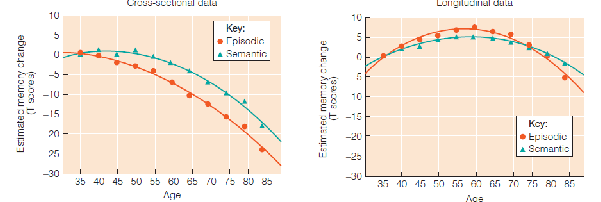
Study by Schnitzspahn et al. (2017); Zuber et al. (2020) on the contextual factors in aging of ex. Prospective memory
= Memory for intentions.
Age-prospective memory paradox: YA > OA in lab, but YA < OA in real life.


Socio-emotional selectivity theory
SOC theory = how to deal with aging effects that take place?
Selection (choosing what you want to keep and improve) Optimizing (training to become better), Compensation (using help if it dont work anhymore)\
Every day context allows you to be more selective (ex. Put alarm clock on to remind you of something) → these strategies are not possible in the lab.
Answer = Socio-emotional selectivity theory
What are the general patterns of Cognitive functioning in older age? High functioning if… (4 reasons) Problems might occur if… (5 reasons)
High functioning if:
• Routines and habits
• Supporting external cues
• Access to prior knowledge
• Clear structure provided
Problems might occur if:
• New situations
• Time pressure
• Several goals followed at the same time
• Tired or distracted
• Senses or body deplete resources (e.g., while walking, bright sunlight,...)
Inter-individual differences (variability)
▪ In addition to mean age trends – important variations within age groups
▪ Wide individual differences within age groups and the age distribution overlap
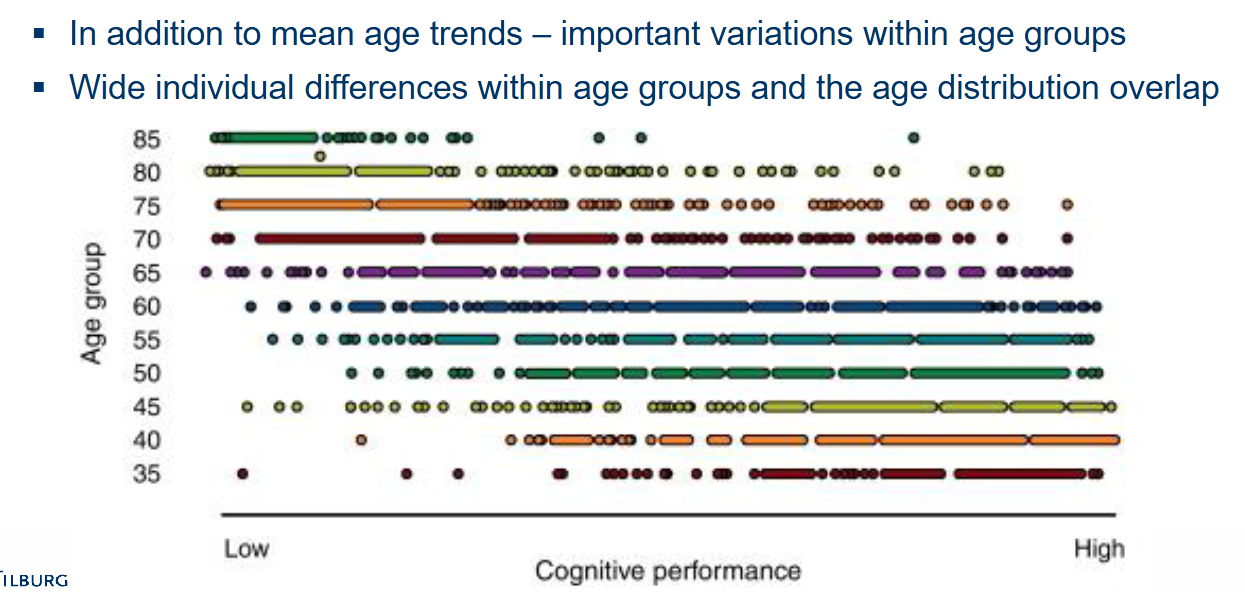
What are intact cognitive abilities for?
They are needed to carry out everyday activities.
Multifactorial background for age-related variability
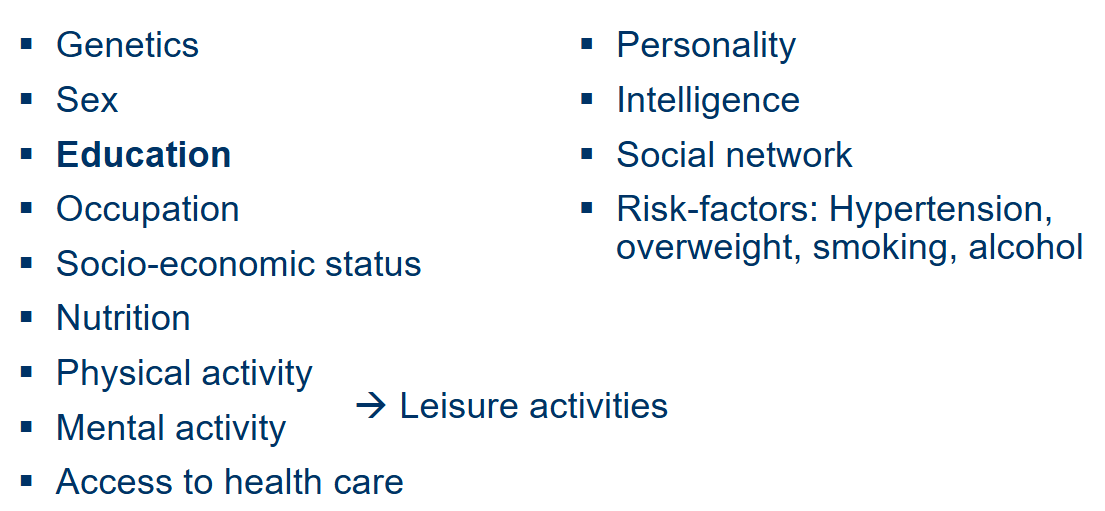
Protection and Resilience: A multisystem approach — Is it possible to minimize or slow down decline in midlife with protective resources?
YES – adaptive lifestyle, modifiable psychosocial and behavioral factors and interventions can reduce the risk for decline and disease
▪ Health and well-being in later life:
Risk factors: Smoking, poor diet, obesity, loneliness
Protective factors: Engaged lifestyle, physical exercise, social support, positive beliefs, sense of control
Beydoun et al. (2014) on the Protection and Resilience: Incident Alzheimer’s disease results?
Low educational attainment and smoking (current/ever) increase relative risks (risk ratios - RRs) for incident Alzheimer’s disease
Physical activity shows protective effects
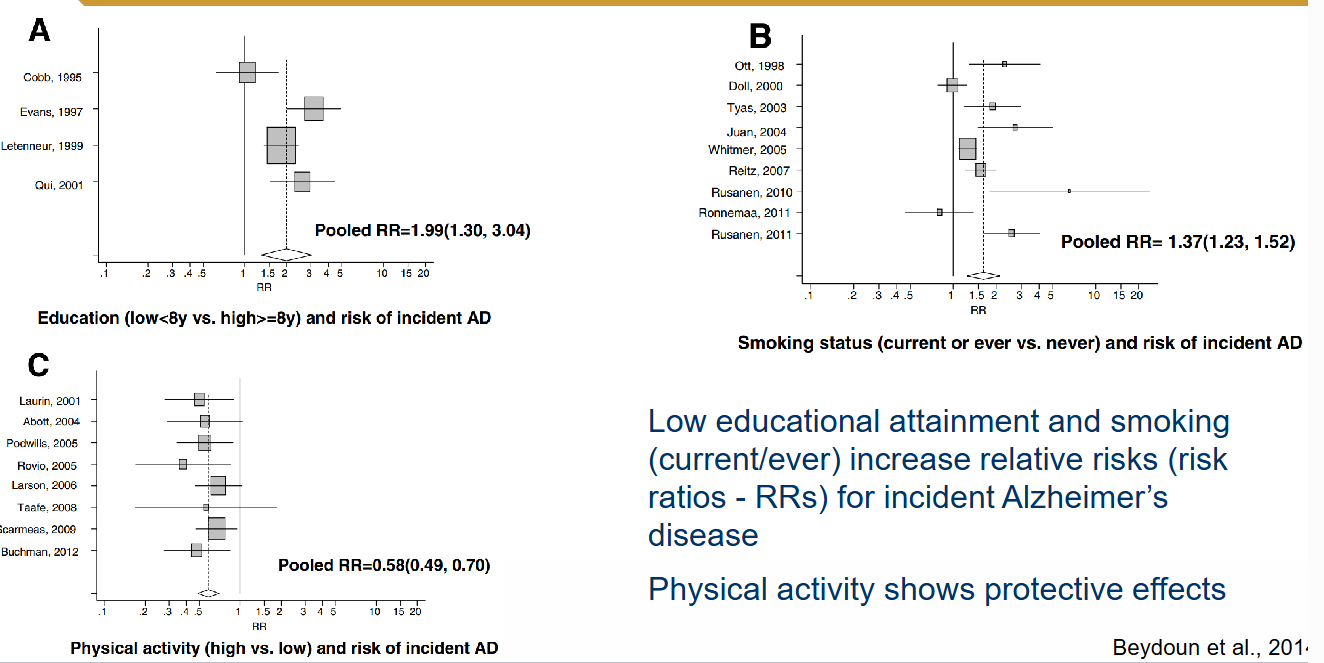
What is Cognitive reserve?
Differences in cognitive processes as a function of lifetime intellectual activities and other environmental factors → Explain differential susceptibility to functional impairment / cognitive decline.
= Cumulative enhancement of neural resources based on genetic and/or environmental factors, helping to mitigate the effects of decline caused by ageing or age-related diseases.
Cognitive reserve can continue to accumulate in older age (beyond childhood and young adulthood)

Results of Barulli & Stern (2013) Research on Cognitive reserve
Striking inter-individual variability: in cross-sectional studies: some 80-year-olds perform as well as, or better than, some 40-year-olds on cognitive tasks that assess functions often impaired by ageing (e.g., episodic memory)
Why is that?
Cognitive reserve: Differences in cognitive processes as a function of lifetime intellectual activities and other environmental factors → Explain differential susceptibility to functional impairment / cognitive decline.
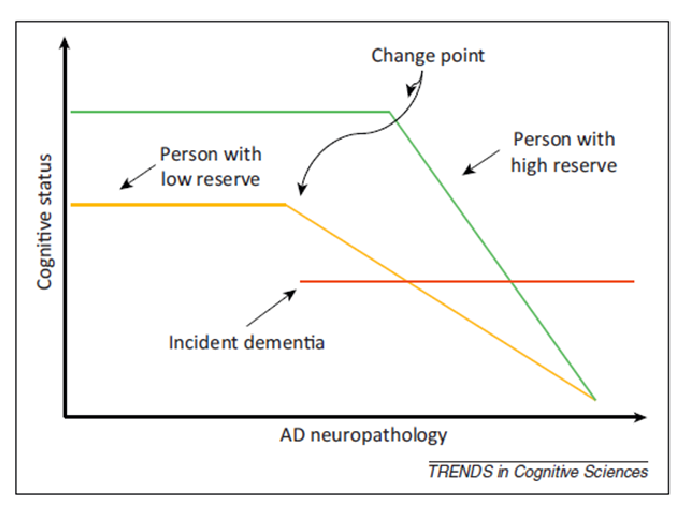
What is the relationship between Cognitive resource and Aging? Ideal and typical
Ideal: Reserve completely counteracts the effects of ageing, with resources meeting or exceeding demands throughout life.
Typical: reserve only attenuates (=lessens the force of) the effects of ageing.

What is Cognitive reserve shaped by?
By cognitive exposures/activities throughout the lifespan, e.g.
• years of education
• crystallized intelligence - knowledge
• degree of occupational complexity
• number of intellectually stimulating leisure activities
• socioeconomic status
What is the relationship between Cognitive reserve and Cognitive decline?
Cognitive reserve serves as buffer (=helps protect from harm) for cognitive decline
Individuals with low cognitive reserve start declining faster and might show pathologies (like Alzheimer’s disease) earlier
Individuals with high cognitive reserve decline later, but usually steeper (once reserves are used up)
